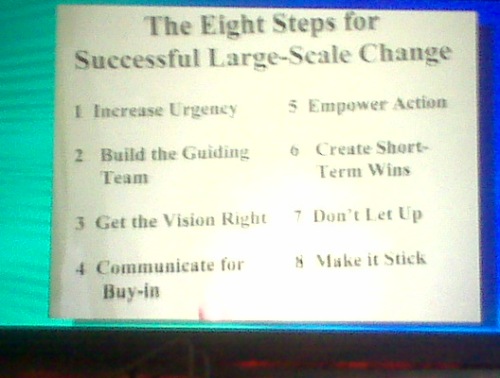Got the computer working. Sorry about the gap. Back to some tidbits from David Kotter’s session.
Overall, this was the best general session of the conference because it came down from 35,000 feet and actually gave tactical advice that I could use.
Kotter also did some very basic, useful things from a media standpoint. He did not use powerpoint, he used a sketch pad, a sharpie, and had the image put up on a screen. Kind of a high tech overhead projector. I have seen professors doing this in college, and Edward DeBono did it in a presentation that I saw. I like it from an adult learning perspective.
He also illustrated one of his basic points – that people are very creative if the environment is right – with videos of first person interviews. The one that had a sewer cleaner narrating how he had personalized his truck and equipment was a refreshing reminder of the creative spirit of the American worker.

Overhead projector with a modern touch
Back to the content. He made the point that a key executive skill is getting traction for systemic change, and that there is a basic pattern for making it happen.
It starts with that poorly-defined but muched talked about ingredient – Leadership.
“Leadership is very much associated with vision. It’s very market oriented, very rational. It’s very much associated with getting people to really, deeply buy in to this, get aligned and work together, going in the same direction to solve problems. It’s also about getting employees pumped up, empowered, motivated, inspired to make shifts happen.”
Then he talked about urgency. He said that most orgnizations clearly aren’t feeling a strong sense of urgency to act when it comes to addressing the impact of our current situation. This lack of urgency directly relates to the change management challenges we are all facing.
Begin with increasing a sense of urgency. It helps shake things up and make things happen
Once this is accomplished, employers need to push for positive change, working to achieve some short term wins that will help make the changes stick.
Companies must create systems that managers can both manage and adapt, allowing positive changes to be triggered and implemented at the front lines of customer service. This is where fear can keep leadership from seeing potential opportunities and, therefore, squelch a sense of urgency to act. This inaction is the barrier to change.
Combine or alternate this fear with compacency, and things get gridlocked.
“Complacency is when you get a collective group that thinks what it is doing is just fine. Take Washington DC, for example. Do you think the two parties are behaving with you in a fundamentally different way than they did five years ago? Do you think the administration is staffing people with a process that is different than any other administration? It’s the same. The same. The same.”
Kotter urged attendees to avoid the frentetic activity that leaves people emotionally drained and burned out. “These problems with our serious economic conditions are hurting a whole lot of people, especially the most vulnerable in our society. This is unacceptable – and also unnecessary.”
I guess what I liked about his approach is that it resonated with the chaos and burnout that I am seeing in modern organizations, and was willing to have the competing issues of complacency and chaos on the same page.
Overall, turn up the urgency, and have a concice plan for change. Then you will be developing the environment andoffering the tools to get some change done.

Kotter's list of 8 steps
Karl, thanks for the report on John Kotter’s talk. Just right for the moment. I’m enjoying your reports. Thanks for providing them!!